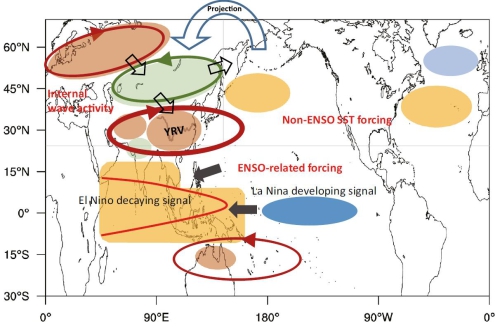Under the global warming, East China is witnessing more heat waves with increasing intensity, for instance, the strongest heat wave over the Yangtze River valley (YRV) in 2013 since 1951 which severely harmed the economy and the health of the population. Therefore, clarifying the main factors responsible for the heat wave variability and their relative contribution is important to improving seasonal-to-annual prediction.
Recently, Dr. CHEN Xiaolong and Prof. ZHOU Tianjun from Institute of Atmospheric Physics, Chinese Academy of Sciences investigated the mechanism of sea surface temperature (SST) forcing and atmospheric internal variability and their relative contributions to interannual variability of heat wave in the YRV. They found that SST forcing can explain about 2/3 heat wave variability and the other 1/3 comes from atmospheric internal variability during 1979-2008. Interestingly, for the SST forcing, there is 1/3 from anomalies independent from the well-known El Niño - Southern Oscillation (ENSO), though the other 1/3 is ENSO’s contribution. All these factors play roles in making heat wave over the YRV through moving the western North Pacific Subtropical High northward, extending it westward and intensifying the anticyclone.
"Both of El Niño decaying in the previous year and La Niña developing in summer could do a favor for heat waves in the Yangtze River valley.” Says CHEN, “The atmospheric internal variability is a circumglobal teleconnection and it shows a tripolar wave train propagating southeastwards over the Eurasia. Non-ENSO SST anomalies, that is warm pattern in the North Pacific and a dipolar pattern in the North Atlantic, can exert its influence by projecting onto the mode of internal variability (Figure 1).”

Three major sources for interannual variability of heat wave in the Yangtze River valley region are ENSO-related, non-ENSO SST forcing and internal variability. Orange and blue shadings represent warm and cold SST anomalies, respectively. Dark red and green shadings represent heat waves and cold anomalies on land, along with anticyclone and cyclone at 500 hPa, respectively. The black hollow arrows point to the direction of Rossby wave propagation. A blue dome-like arrow at the top denotes the effect of non-ENSO SST forcing on the YRV heat wave via projecting onto the internal mode.
Their findings reveal the internal variability shares its way to forcing from the extratropical SST anomalies to raise heat waves over the YRV. Further analysis shows the intensification of heat wave variability after the end of 1990s is associated with the above circumglobal teleconnection in which both the non-ENSO SST forcing and internal variability are involved. This study indicates that learning the predictability of extratropical SST, except for ENSO, can potentially improve the seasonal forecast skill of heat waves in East China.
Reference:
Chen Xiaolong & Zhou Tianjun, 2017: Relative contributions of external SST forcing and internal atmospheric variability to July–August heat waves over the Yangtze River valley. Clim. Dyn., doi:10.1007/s00382-017-3871-y. https://link.springer.com/article/10.1007%2Fs00382-017-3871-y
Contact: CHEN Xiaolong, chenxl@lasg.iap.ac.cn
